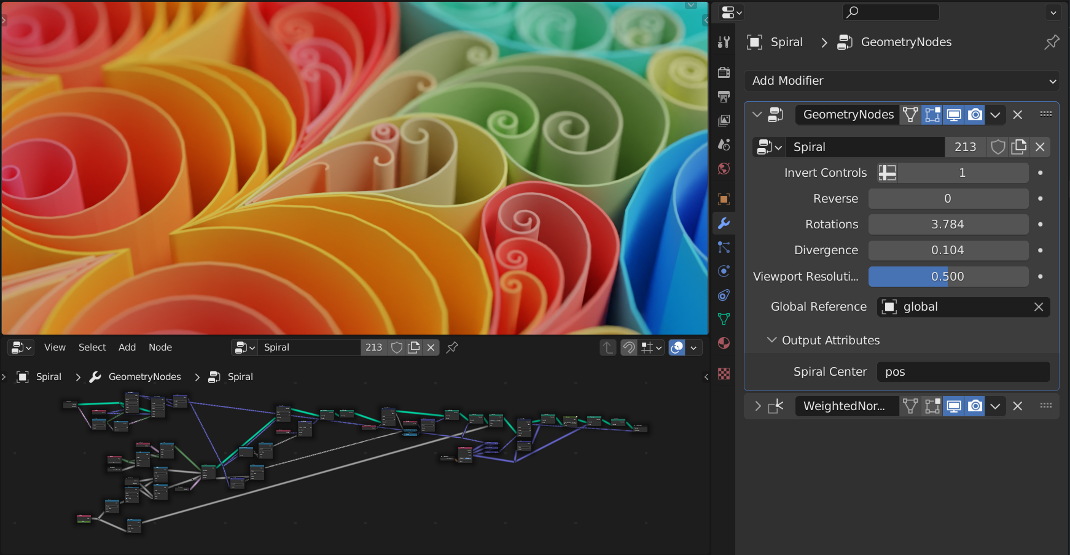Introduction
I stumbled upon the incredibly fascinating and creative world of 3D back in 2008 when I visited my high school's computer club, where I encountered the mesmerizing software known as Blender. Today, I've turned that passion into my profession. I'm a freelance 3D graphic designer, and my enthusiasm for the craft remains as strong as it was back then.
In this article, I'll attempt to answer the question in my own way: Why use Blender?
Diverse Profiles
First and foremost, it's crucial to define who uses Blender as it provides context and helps in shaping our response to the main question.
Everyone should be free to create 3D CG content, with free technical and creative production means and free access to markets.
That's the vision of the Blender Foundation (the organization behind Blender). You can find it on their website. From this quote, we can see that Blender is intended for everyone, whether you're a student, a small business, a freelancer, a studio, an interested amateur, and beyond.
Cost-Free
Unsurprisingly, the first answer that comes to mind is Blender's cost-free nature. This means that anyone can acquire it without worrying about the price of a license. Nowadays, most of the major 3D software that serve as industry standards come with hefty price tags. Having to invest in software licenses can discourage students who wish to learn or pose financial challenges for businesses that need to limit the number of licenses to save costs.
The Open Source World and Its Community

One of Blender's most remarkable features lies in its open-source status, built upon the GNU GPL license. This foundation ensures that Blender will remain free forever and allows all users to access its source code, review it, and modify it. This freedom of source code access has opened doors to a global community of developers. Some dedicate themselves to fixing small bugs and enhancing existing features, while others create new revolutionary tools and functionalities.
A notable example of this innovation is the Eevee rendering engine, which is now one of Blender's two rendering engines. Originally developed by an independent developer, it illustrates the collaborative and open nature of the Blender community. It also demonstrates that Blender doesn't rely solely on the developers of the Blender Foundation but leans on a broad range of external contributors.
Open access to the source code offers significant flexibility for integrating new tools without risking conflicts with the software's existing features. Moreover, Blender supports the Python programming language, which is relatively easy to use. This means that a motivated freelancer can create their own complex tools by harnessing Blender's customization potential. Additionally, many companies, including industry giants, develop their own Blender tools in-house to meet their specific production needs. For instance, it was thanks to Tangent Animation that Blender integrated the Cryptomatte tool, originally developed in-house to meet specific production needs. Later, the tool became open-source and was included in Blender by default. This combination of accessibility for customization and support from renowned companies and grassroots developers makes Blender a versatile and adaptable 3D software.
Furthermore, the Blender Foundation, as a nonprofit organization, relies primarily on donations to fund its development. This funding structure highlights the extensive and committed Blender community. More than 130,000 euros in donations are collected each month, which is used to compensate developers and advance the software. This sum comes from contributions not only from freelancers but also from major companies that trust the Blender Foundation and want to invest in this software.
Among these companies, you'll find enormous names in the tech industry, including Google, Meta, AWS, Nvidia, AMD, Intel, and many others. Their financial support is a clear sign of Blender's credibility and its promise as a serious software. It's worth noting that some of these companies aren't directly tied to the animation industry, but they actively contribute to Blender's development in addition to their financial donations. For example, Nvidia, AMD, and Intel provide their developers to ensure the compatibility of their products with Blender, strengthening its status as the go-to choice for 3D creation.
Blender's Versatility
One of Blender's most striking features is its versatility. It provides artists with a comprehensive toolbox for all stages of a 3D production pipeline, including design, creation, rendering, composition, animation, special effects, sculpting, and many other domains. This versatility is essential in an industry where it's common to see productions using multiple specialized software throughout the creation process. However, this can sometimes lead to compatibility issues when transitioning from one software to another.
It's important to note that while Blender offers a wide range of tools, it might not be the best in every single area compared to software specifically designed for those tasks. Nevertheless, over the years, Blender has refined and improved its tools to become increasingly competitive with other industry software. Regular updates introduce new features, optimize performance, and enhance the user experience.

This aspect is even more significant due to Blender's logical consistency. By staying within the same software throughout the process, artists have the opportunity to set up tools and techniques from the beginning of their projects. This continuity in the workflow saves time, reduces potential errors, and offers a smoother creative experience. This unified approach to the creative process can be particularly beneficial because it allows the application of techniques and knowledge throughout production without the disruptions that can arise when transitioning between multiple specialized software.
A major evolution in the world of Blender is the introduction of node systems for many tools. These systems are highly versatile, catering to both beginners and experienced users. They have become an integral part of why Blender competes with industry-standard software. Substantial efforts have also been made to enhance Blender's usability and productivity. New highly anticipated tools have emerged, existing tools have been refined, and adjustments have been made to the user interface to provide a smoother experience.

It's important to note that these tools are still in their early stages in Blender. The Blender Foundation is committed to delivering stable, quality software, which is why these significant features are progressively implemented. With each new version, powerful tools are destined to evolve and improve. This progressive approach ensures that each new feature is functional and doesn't disrupt artists' workflows. This means Blender users can expect ongoing improvements and exciting new features as the software evolves.
Despite Blender's versatility, it's essential to highlight that the software hasn't become unfocused. Quite the opposite; in recent years, the Blender Foundation has restructured to allocate some of its time to bug fixing and ensuring software stability. A well-defined release schedule of three stable versions per year accelerates Blender's evolution. In comparison, many other 3D software releases only one version per year, which means users have to wait a long time for new features.

Furthermore, Blender introduced Long Term Support (LTS) versions, ensuring continuous support for two years. This is ideal for studios and productions looking to maintain software stability throughout their projects.
Lastly, thanks to its dynamic community and open-source nature, Blender boasts a multitude of addons—extensions that fill potential gaps in the software in various areas. This further strengthens Blender's versatility, allowing users to customize their experience based on their specific needs. It also sets the stage for the next section of this article, which explores the importance of the Blender community.
The Blender Community
In this section dedicated to the Blender community, we shed light on one of the most remarkable aspects of this ecosystem: the spirit of mutual support. While we've mentioned the community throughout this article, it's essential to underscore this distinctive trait. The Blender community draws its values from the world of open-source software, particularly the philosophy of knowledge sharing. In addition to the transparency demonstrated by the Blender Foundation in software development and official documentation, a plethora of online tutorials are available for users at all levels. Whether in the form of YouTube videos, written articles, e-books, forums, or learning programs, resources abound. Whether you're a novice seeking to master the basics or a professional grappling with complex challenges, a simple online question is often followed by quick and helpful responses. Even if the solution isn't immediately evident, you'll find people willing to assist you in the quest for a solution.
What's particularly impressive and worth noting is the benevolence that characterizes the Blender community. In general, there's a dearth of judgment and plenty of encouragement among its members. Blender users have confidence in their software, but they don't seek to impose the notion that Blender is unquestionably the best 3D software, relegating others to obscurity. They understand that, while powerful, Blender may not be the best choice in every case. This attitude contrasts with some other communities, where a sense of superiority towards other software is more common.
Throughout the writing of this article, we've mainly discussed the developers' contributions to the community. However, it's essential to remember that the Blender community encompasses all users, whether they're novices or experienced. Each of them plays an active role by participating in forums, blogs, answering others' questions, contributing to documentation, translating, offering opinions on the current state of the software, and much more.
The Blender Foundation is acutely aware of the wealth that such an engaged and goodwill-filled community represents. That's why it expends considerable efforts to collaborate with the community. As mentioned earlier, the organization restructured itself to clearly define the priorities and objectives of each new Blender version, taking into account community input. This user involvement in decisions about software development is an impressive aspect of the relationship between the Blender Foundation and its community. This participation demonstrates the respect and consideration that the Blender Foundation holds for its users, further bolstering community engagement.
Conclusion
Blender stands out as an excellent 3D creation software accessible to all and catering to a variety of needs in a resource-rich and collaborative environment.
In addition to being cost-free and versatile, it's supported by an incredible, caring, and invested community.
It's no wonder that today more and more studios and productions are adopting Blender. Graphic design schools are also integrating it into their curriculum.
In summary, Blender represents much more than just 3D software. It embodies a philosophy of freedom, collaboration, and sharing while offering powerful and evolving tools. Blender's history shows that creativity can be unleashed without financial constraints and that the collective effort of a dedicated community can advance technology and open new opportunities for everyone. Regardless of your experience level and goals, Blender provides a platform to unleash your imagination and realize your 3D dreams. So, why use Blender? Why not?

Yves Perera
Passionate 3D graphic designer who places great importance on communication and the quality of work done.



